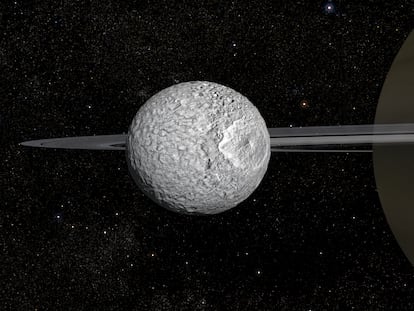‘Odysseus’ successfully launches, aiming to be first US-made lander to reach the moon in half a century
The Intuitive Machines probe aims to become the first private device to land on the satellite next week

Half a century after its last mission to the moon, the United States is trying again to reach the Earth’s satellite. The Odysseus lander is now on its way to the moon after a successful launch at 1:05 a.m. from the U.S. base at Cape Canaveral, Florida. It was lifted off atop a SpaceX Falcon 9 rocket.
Odysseus is a new model of lander called Nova-C. It is made by the company Intuitive Machines, which aims to land on the Moon on Thursday, February 22, after a little more than a week of space adventure. The lander is carrying six devices that NASA wants to place on the lunar surface. If it achieves it, Odysseus will become the first U.S. spacecraft to land successfully on the moon since the Apollo 17 mission in 1972. It will also be the first private lander to land on the moon.
The launch comes after a bumpy few months for other competitors in the space race. The success rate for lunar landers remains below 50% and the statistics have not improved in recent years. Indeed, no private lander has successfully landed on the moon. Israel’s Beresheet in 2019, Japan’s Hakuto-R in 2023 and Astrobotic’s Peregrine in January 2024 all ended in failure.
This latest U.S. attempt — driven by NASA — involved the loss of the Peregrine spacecraft, which suffered a propulsion failure and ended up deliberately disintegrating against the Earth’s atmosphere. Russia’s Luna-25 spacecraft also crashed in 2023, but India’s Vikram successfully landed last year. Japan’s SLIM probe also made it in January, although it landed on its side.
There was an extra component of innovation to the launch, since SpaceX’s Falcon 9 was powered for the first time by methane, a fuel that China had previously successfully used for launches. As a result of this change, a new way to fill the rocket’s tanks had to be devised and also led to the launch being pushed back from Tuesday due to a problem with the methane temperature.

Odysseus is carrying 12 payloads, half of those for NASA, which is using collaborations with private companies to make gradual, inexpensive progress on its Artemis program to return to the moon. It is also carrying six commercial artifacts, such as an urn with lunar sculptures by renowned artist Jeff Koons.
This mission is called IM-1. It seeks to land Odysseus near the Malapert A crater, 161 miles from the lunar south pole — the coveted icy region, near where India successfully landed its probe. The goal is to be able to exploit the gigantic resource of water ice for future space exploration. Intuitive Machines, which claims to have learned from previous failures, intends to launch the IM-2 mission by the end of this year and IM-3 in 2025.
NASA science is nestled aboard @Int_Machines’s Nova-C lander, set to launch to the Moon on a @SpaceX Falcon 9 rocket. Landing near the Malapert A crater will help us learn more about the lunar South Pole, a big step in our #Artemis campaign. https://t.co/oT7m0a8PwX
— NASA (@NASA) February 15, 2024
These missions are being carried out in the context of NASA’s CLPS initiative, which seeks to accelerate lunar exploration through contracts with private companies: it does not launch the rockets, it just buys a ticket on board. In this case, it paid $118 million to the publicly held company to carry its instruments. NASA had to postpone its plans for a crewed mission to the moon precisely because of the technical problems with several of the companies involved.
Sign up for our weekly newsletter to get more English-language news coverage from EL PAÍS USA Edition
Tu suscripción se está usando en otro dispositivo
¿Quieres añadir otro usuario a tu suscripción?
Si continúas leyendo en este dispositivo, no se podrá leer en el otro.
FlechaTu suscripción se está usando en otro dispositivo y solo puedes acceder a EL PAÍS desde un dispositivo a la vez.
Si quieres compartir tu cuenta, cambia tu suscripción a la modalidad Premium, así podrás añadir otro usuario. Cada uno accederá con su propia cuenta de email, lo que os permitirá personalizar vuestra experiencia en EL PAÍS.
¿Tienes una suscripción de empresa? Accede aquí para contratar más cuentas.
En el caso de no saber quién está usando tu cuenta, te recomendamos cambiar tu contraseña aquí.
Si decides continuar compartiendo tu cuenta, este mensaje se mostrará en tu dispositivo y en el de la otra persona que está usando tu cuenta de forma indefinida, afectando a tu experiencia de lectura. Puedes consultar aquí los términos y condiciones de la suscripción digital.
More information
Archived In
Últimas noticias
Maduro pleads not guilty before the federal court in New York: ‘I am still the president of Venezuela’
A new test can detect Alzheimer’s from a finger prick
UN team enters Sudanese city of El Fasher after paramilitary massacre: ‘It’s like a ghost town’
A recipe for resistance: Indigenous peoples politicize their struggles from the kitchen
Most viewed
- Gilles Lipovetsky: ‘If you want to live better and fall in love, take Prozac, don’t look to philosophy’
- Alain Aspect, Nobel laureate in physics: ‘Einstein was so smart that he would have had to recognize quantum entanglement’
- Alvin Hellerstein, a 92-year-old judge appointed by Bill Clinton, to preside over Maduro’s trial in New York
- Why oil has been at the center of Venezuela-US conflicts for decades
- Maduro’s downfall puts China’s relationship with Venezuela to the test











































